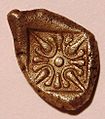Quadratum incusum
In ancient Greek coinage, quadratum incusum refers to a recessed, image-free reverse of the coins. At the beginning of coinage only primitive, punch-shaped stamps without design were used. Since the 6th century BC, these hallmarks were increasingly replaced by a quadratum incusum, which was mostly divided into four sub-squares, but occasionally also into even more simple geometric sub-surfaces. This subdivision into sub-areas was replaced by an ornamental design of the quadratum incusum. In classical times, the horizontal bar of the quadratum incusum on coins from the island of Chios was given a magistrate's name, which was probably responsible for the coinage. Later, parts of the Quadratum incusums were also provided with small motifs (for example insects on the coins from Chersonese ). Finally, images on the entire reverse of the coin replaced the quadratum incusum.
The development was not the same in all cities. It happened that cities used very simple designs for the reverse of their coins, while in other cities a more elaborate design had long been established. This was often intended to mark the coin as good (in the sense of high silver content), traditional money. The most obvious development is shown by the coins from the island of Aegina (now Aegina ). The four sub-squares of the quadratum incusum are often again diagonally divided into triangles, partially filled and partially remaining empty, which leads to a windmill-like appearance when alternating filled and empty triangles. But there are also periods with five empty and three filled triangles. In the final phase of the Aeginetic coinage, the four-part quadratum incusum is replaced by five irregularly shaped trapezoids. The chronological development of the Aeginian coins can now be easily traced through various hoard finds.
The quadratum incusum was only used on electron and silver coins. When the very small silver denominations were replaced by larger and more manageable bronze coins, the quadratum incusum was no longer used to design the reverse of the coin.
Picture gallery of the development of the reverse of the coin
Obol from Kamiros (Rhodes) with an undesigned hallmark on the back, 6th century BC Chr.
Stater from Aegina , back: Quadratum incusum with five wings, approx. 550–456 BC Chr.
Obol from Miletus , reverse: stylized star in Quadratum incusum, 6th century BC Chr.
Stater from Chios , reverse: quadruple quadratum incusum, approx. 480–450 BC Chr.
Diobol from Samos , reverse side with stylized star in multi-row quadratum incusum, 6./5. Century BC Chr.
Stater from Korkyra with designed quadratum incusum: stylized double flower, approx. 475–450 BC Minted
Drachm from Parion , reverse: quadratum incusum, multiple and simple subdivided, 5th century BC Chr.
Front and back Triobol from Chersonese , motifs on partial areas of the quadruple quadratum incusums on the back (right), approx. 400–350 BC Chr.
Drachm from Byzantion , wind-wing-like, four-part quadratum incusum, 357-340 BC Chr.
Rhodiapolis , Lyra in Quadratum incusum, S / S 5398 Rv, after 168 BC. Chr.
literature
- Heinrich Chantraine : coinage. In: The Little Pauly (KlP). Volume 3, Stuttgart 1969, Col. 1447-1452.
Individual evidence
- ^ Peter Franz Mittag, Greek Numismatics - An Introduction, Heidelberg 2016, page 59, ISBN 978-3-938032-85-5
- ^ Peter Franz Mittag, Greek Numismatics - An Introduction, Heidelberg 2016, pages 64 - 65, ISBN 978-3-938032-85-5









